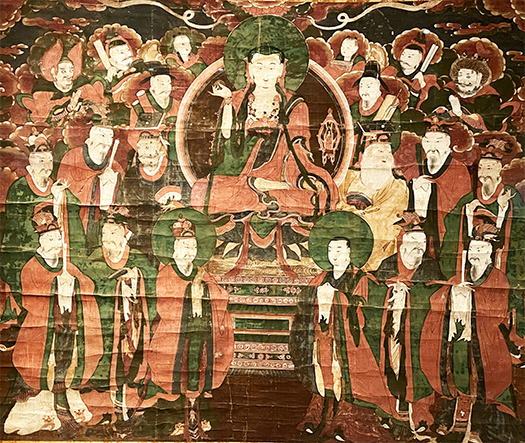
加齢してきて、自分自身をテーマにして少しは「いのち」というものと向き合うような気分に納得感が生まれ出てくるようになってきた気がします。「おいおい、今更かよ(笑)」と笑われそうですが、いろいろなこの世でのことに区切りを付けるという結節点がやがてやってくるという実感は、やはり自分自身にとって大きな心理的変化だと思っています。
で、当然ですが先人のみなさんも同じことに深くとらわれて生きてきたことは間違いがない。
そういう時間を超えた人間同士の「対話」の機会、空間として宗教というのはその存在意義があったのでしょう。ようやくその当たり前のことに思いが至ってきている。いかにも遅い(笑)。
わたしは、人間が生み出してきた芸術・美術という精神の「外化」されたものに強くこころが奪われています。さまざまな先人達のこころの叫び声のようなものがそれらには格納されている。
少年期には仏陀などには関心も持たず、いわんや異人さんたちの崇めるキリスト教一神教の社会構造の中で教会に奉仕するかのような宗教画には拒絶反応も持った。そういうなかでモナリザとか、モネの睡蓮シリーズなどの直接宗教とは関わらないテーマには反応はした。
一方で日本では鳥獣戯画を嚆矢とするような最初から自由な空気感に満ちた「マンガ」的表現が奔放に展開していたのではないかと思っていた。俵屋宗達の「風神雷神」などにも、日本人の縛られない精神性が表現されていると思う。
そういうことで生きてきたけれど、最近は、仏像や宗教画(仏教絵画)にも、そういう精神性が深く宿っていることにしんしんと気付かされている。額田王をモデルとしたと言われている「石位寺 石造浮彫伝薬師三尊像」を知人の紹介で参観させていただいたときに、その仏としての「表情」に深い人間性の刻印をみたことが大きかったか、いや、それ以前に止利仏師の作とされる飛鳥大仏の表情に、深く癒されていたことがあっただろうか。
わたし側の見方と生き方が変化していくことでそういう側面への感受性が大きくなって来たと言うことなのかも知れない。同じ人間同士、先人が感じていた苦悩や解脱などのの心象が、興味深い対象として自ずと大きくなって来たのかも知れない。
ということで、いまのところ、キリスト教世界の宗教画にはそういう機縁は得られていませんが、多少は日本だけでなく、写真の朝鮮の仏教美術「地獄十王図軸」といったアジアの古仏教美術などからすこしづつ、やがて世界共通的な世界観に至れるものか、恐る恐る近づき始めております(笑)。
English version⬇
The relationship between the human mind, its expression in art, and religion.
The architectural space of temples has functioned as a Japanese “asylum” because of the prayer for “eventual salvation from this unholy land. Dialogue with such a mind. …
As I have aged, I feel that I have come to have a more satisfying sense of “life” as a theme for my own life. I am sure I will be laughed at for saying, “Oh, come on, it’s too late now (laugh),” but I think it is a big psychological change for me to realize that the nexus of bringing various things in this world to a close will eventually come.
And, of course, there is no doubt that our predecessors have lived their lives with the same deep preoccupation.
Religion must have had its raison d’etre as an opportunity and space for “dialogue” between people that transcended time. We are finally coming to realize the obvious. How late it is (laughs).
I am strongly fascinated by the spiritual “externalization” of art and art produced by human beings. They contain the cries of the hearts of our predecessors.
When I was a boy, I was not interested in the Buddha, and I rejected religious paintings that seemed to serve the church in the Christian monotheistic social structure worshipped by foreigners, so to speak. In such a situation, he did respond to themes not directly related to religion, such as the Mona Lisa and Monet’s Waterlilies series.
On the other hand, I thought that in Japan, there was an unrestrained development of “manga” style expression filled with a sense of freedom from the very beginning, as in the pioneering “Birds and Beasts” caricatures. I believe that the unbounded spirituality of the Japanese is expressed in works such as Sotatsu Tawaraya’s “Fujin Raijin” (Wind God and Thunder God).
I have lived my life in such a way, but recently I have been reminded that such spirituality is deeply embedded in Buddhist statues and religious paintings (Buddhist paintings) as well. Perhaps it was because I was deeply healed by the expression on the face of the Great Buddha of Asuka, which is said to have been created by the great Buddhist monk Toributsuji, when I visited the “Stone relief statue of Yakushi Sanzon,” which is said to be modeled after King Nukata, through the introduction of an acquaintance. Or perhaps I had been deeply healed by the expression on the face of Asuka Daibutsu, which is said to have been created by the great Buddhist priest Shuri.
Perhaps my sensitivity to this aspect has grown as my way of looking at and living in the world has changed. As fellow human beings, the mental images of suffering and liberation that our predecessors felt may have naturally grown as interesting subjects.
I have not been able to find such an opportunity in religious paintings of the Christian world, but I am beginning to approach the world with some fear, hoping that I can eventually reach a common world view, not only in Japan but also in other Asian ancient Buddhist arts such as the “Ten Kings of Hell” Buddhist art of Korea shown in the photo. (Laughs).
Posted on 3月 23rd, 2024 by 三木 奎吾
Filed under: 歴史探訪







コメントを投稿
「※誹謗中傷や、悪意のある書き込み、営利目的などのコメントを防ぐために、投稿された全てのコメントは一時的に保留されますのでご了承ください。」
You must be logged in to post a comment.